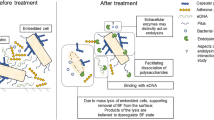Abstract
Background
Aeromonas hydrophila is an important foodborne and zoonotic pathogen causing serious diseases. Hence, revealing the pathogenic mechanism of A. hydrophila will be of importance in the development of novel therapies. Aeromonas hydrophila litR was reported to be regulated by two quorum sensing (QS) pathways, indicating that it is involved in QS network regulation correlated with bacterial virulence. However, the function of LitR is currently not understood. Therefore, we aimed to reveal the potential regulatory mechanisms of LitR on virulence-related genes.
Methods and results
In this study, amino acid sequences analysis of LitR was conducted, providing bioinformatics evidence for its function as a potential transcriptional regulator. LitR protein was heterologous expressed, purified and its in-vitro multimeric forms were observed with gel filtration chromatography. The correlation between intracellular LitR expression level and cell density was analyzed with immunoblots. Regulation mechanisms of LitR on several important virulence-related factors were investigated with qRT-PCR, EMSA, DNase I footprinting and microscale thermophoresis binding assays, etc. Results showed that recombinant LitR protein aggregated mainly as dimer and hexamer in vitro. Intracellular expression level of LitR was positively correlated with cell density of A. hydrophila. Furthermore, LitR exhibited complicated regulation modes on virulence-related genes; it could directly bind to promoter regions of the hemolysin, serine protease and T6SS effector protein VgrG encoded genes. The promoter region of the hemolysin gene showed high binding affinity and mainly two binding sites for LitR. Different dissociation constants were obtained for LitR interaction with the hemolysin gene binding motifs I and II. Assays focusing on physiological characteristics of A. hydrophila prove that LitR positively regulated hemolytic and total extracellular protease activities.
Conclusions
This study investigated the function of LitR as a quorum sensing transcriptional regulator in regulation of virulence-related genes, which will help reveal the mechanisms of A. hydrophila pathogenicity. LitR could serve as a potential target for development of new antimicrobial agents from the perspective of QS regulation.





Similar content being viewed by others
Data availability
The datasets generated and analysed and the materials used during the current study are available from the corresponding author on reasonable request.
References
Aytac SA, Taban BM (2014) Food-borne microbial diseases and control: food-borne infections and intoxications. In: Malik A, Erginkaya Z, Ahmad S, Erten H (eds) Food processing: strategies for quality assessment. Springer, New York, pp 191–224
Jahid IK, Lee NY, Kim A, Ha SD (2013) Influence of glucose concentrations on biofilm formation, motility, exoprotease production, and quorum sensing in Aeromonas hydrophila. J Food Prot 76(2):239–247
Alhazmi MI (2015) Isolation of Aeromonas spp. from food products: emerging Aeromonas infections and their significance in public health. J AOAC Int 98(4):927–929
Zhang Q, Shi GQ, Tang GP, Zou ZT, Yao GH, Zeng G (2012) A foodborne outbreak of Aeromonas hydrophila in a college, Xingyi City, Guizhou, China. West Pac Surveill Response J 3(4):39–43
Stratev D, Odeyemi OA (2016) Antimicrobial resistance of Aeromonas hydrophila isolated from different foodsources: a mini-review. J Infect Public Health 9(5):535–544
Tsheten T, Tshering D, Gyem K, Dorji S, Wangchuk S, Tenzin T, Norbu L, Jamtsho T (2016) An outbreak of Aeromonas hydrophila food poisoning in Deptsang Village, Samdrup Jongkhar, Bhutan. J Res Health Sci 16(4):224–227
Tomás JM (2012) The main Aeromonas pathogenic factors. ISRN Microbiol 2012:256261
Pang M, Xie X, Dong Y, Du H, Wang N, Lu C, Liu Y (2017) Identification of novel virulence-related genes in Aeromonas hydrophila by screening transposon mutants in a Tetrahymena infection model. Vet Microbiol 199:36–46
Miller MB, Bassler BL (2001) Quorum Sensing in bacteria. Annu Rev Microbiol 55:165–199
Boyer M, Wisniewski-Dyé F (2009) Cell-cell signaling in bacteria: not simply a matter of quorum. FEMS Microbiol Ecol 70(1):1–19
Ng WL, Bassler BL (2009) Bacterial quorum-sensing network architectures. Annu Rev Genet 43:197–222
Whiteley M, Diggle SP, Greenberg EP (2017) Progress in and promise of bacterial quorum sensing research. Nature 551(7680):313–320
Khajanchi BK, Sha J, Kozlova EV, Erova TE, Suarez G, Sierra JC, Popov VL, Horneman AJ, Chopra AK (2009) N-acylhomoserine lactones involved in quorum sensing control the type VI secretion system, biofilm formation, protease production, and in vivo virulence in a clinical isolate of Aeromonas hydrophila. Microbiology 155(11):3518–3531
Kozlova EV, Popov VL, Sha J, Foltz SM, Erova TE, Agar SL, Horneman AJ, Chopra AK (2008) Mutation in the S-ribosylhomocysteinase (luxS) gene involved in quorum sensing affects biofilm formation and virulence in a clinical isolate of Aeromonas hydrophila. Microb Pathog 45(5–6):343–354
Lorenz N, Shin JY, Jung K (2017) Activity, abundance, and localization of quorum sensing receptors in Vibrio harveyi. Front Microbiol 8:634
Zhao J, Zhang FR, Cui Y, Xu YB, Chen M, Quan CS, Fan SD (2015) In vitro biosynthesis and activity detection of quorum sensing signal molecule AI-2 of Aeromonas hydrophila. Microbiol China 42(10):1858–1865 (in Chinese)
Kozlova EV, Khajanchi BK, Sha J, Chopra AK (2011) Quorum sensing and c-di-GMP-dependent alterations in gene transcripts and virulence-associated phenotypes in a clinical isolate of Aeromonas hydrophila. Microb Pathog 50(5):213–223
Natrah FMI, Alam MI, Pawar S, Harzevili AS, Nevejan N, Boon N, Sorgeloos P, Bossier P, Defoirdt T (2012) The impact of quorum sensing on the virulence of Aeromonas hydrophila and Aeromonas salmonicida towards burbot (Lota lota L.) larvae. Vet Microbiol 159(1–2):77–82
Sha J, Rosenzweig JA, Kozlova EV, Wang S, Erova TE, Kirtley ML, van Lier CJ, Chopra AK (2013) Evaluation of the roles played by Hcp and VgrG type 6 secretion system effectors in Aeromonas hydrophila SSU pathogenesis. Microbiology 159(Pt 6):1120–1135
Zhao J, Chen M, Quan CS, Fan SD (2015) Mechanisms of quorum sensing and strategies for quorum sensing disruption in aquaculture pathogens. J Fish Dis 38(9):771–786
van Den Ent F, Löwe J (2006) RF cloning: a restriction-free method for inserting target genes into plasmids. J Biochem Biophys 67(1):67–74
Unger T, Jacobovitch Y, Dantes A, Bernheim R, Peleg Y (2010) Applications of the restriction free (RF) cloning procedure for molecular manipulations and protein expression. J Struct Biol 172(1):34–44
Bond SR, Naus CC (2012) RF-Cloning org: an online tool for the design of restriction-free cloning projects. Nucleic Acids Res 40(1):209–213
Mueller AM, Breitsprecher D, Duhr S, Baaske P, Schubert T, Langst G (2017) Microscale thermophoresis: a rapid and precise method to quantify protein-nucleic acid interactions in solution. Methods Mol Biol 1654:151–164
Bendicho S, Marti G, Hernatndez T, Martin O (2002) Determination of proteolytic activity in different milk systems. Food Chem 79:245–249
Yu HB, Zhang YL, Lau YL, Yao F, Vilches S, Merino S, Tomas JM, Howard SP, Leung KY (2005) Identification and characterization of putative virulence genes and gene clusters in Aeromonas hydrophila PPD134/91. Appl Environ Microbiol 71(8):4469–4477
Pompeani AJ, Irgon JJ, Berger MF (2008) The Vibrio harveyi master quorum-sensing regulator, LuxR, a TetR-type protein is both an activator and a repressor: DNA recognition and binding specificity at target promoters. Mol Microbiol 70(1):76–88
Rutherford ST, van Kessel JC, Shao Y (2011) AphA and LuxR/HapR reciprocally control quorum sensing in vibrios. Genes Dev 25(4):397–408
van Kessel JC, Rutherford ST, Shao Y (2013) Individual and combined roles of the master regulators AphA and LuxR in control of the Vibrio harveyi quorum-sensing regulon. J Bacteriol 195(3):436–443
Kalburge SS, Carpenter MR, Rozovsky S, Boyd EF (2017) Quorum sensing regulators are required for metabolic fitness in Vibrio parahaemolyticus. Infect Immun 85(3):e00930-e1016
Kim Y, Kim BS, Park YJ (2010) Crystal structure of SmcR, a quorum-sensing master regulator of Vibrio vulnificus, provides insight into its regulation of transcription. J Biol Chem 285(18):14020–14030
Kim SM, Lee DH, Choi SH (2012) Evidence that the Vibrio vulnificus flagellar regulator FlhF is regulated by a quorum sensing master regulator SmcR. Microbiology 158(8):2017–2025
Kim IH, Wen Y, Son JS (2013) The fur-iron complex modulates expression of the quorum-sensing master regulator, SmcR, to control expression of virulence factors in Vibrio vulnificus. Infect Immun 81(8):2888–2898
Tsou AM, Cai T, Liu Z (2009) Regulatory targets of quorum sensing in Vibrio cholerae: evidence for two distinct HapR-binding motifs. Nucleic Acids Res 37(8):2747–2756
Tsou AM, Liu Z, Cai T (2011) The VarS/VarA two-component system modulates the activity of the Vibrio cholerae quorum-sensing transcriptional regulator HapR. Microbiology 157(6):1620–1628
van Kessel JC, Ulrich LE, Zhulin IB, Bassler BL (2013) Analysis of activator and repressor functions reveals the requirements for transcriptional control by LuxR, the master regulator of quorum sensing in Vibrio harveyi. MBio 4(4):e00378-e413
Singh R, Rathore YS, Singh NS, Peddada N, Ashish, Raychaudhuri S (2013) Substitution of glutamate residue by lysine in the dimerization domain affects DNA binding ability of HapR by inducing structural deformity in the DNA binding domain. PLoS ONE 8(10):e76033
Rasmussen-Ivey CR, Figueras MJ, McGarey D, Liles MR (2016) Virulence factors of Aeromonas hydrophila: in the wake of reclassification. Front Microbiol 7:1337
Barger PC, Liles MR, Newton JC (2020) Type II secretion is essential for virulence of the emerging fish pathogen, hypervirulent Aeromonas hydrophila. Front Vet Sci 7:574113
Jin L, Chen Y, Yang W, Qiao Z, Zhang X (2020) Complete genome sequence of fish-pathogenic Aeromonas hydrophila HX-3 and a comparative analysis: insights into virulence factors and quorum sensing. Sci Rep 10:15479
Liu J, Dong Y, Wang N, Li S, Yang Y, Wang Y, Awan F, Lu C, Liu Y (2018) Tetrahymena thermophila predation enhances environmental adaptation of the Carp pathogenic strain Aeromonas hydrophila NJ-35. Front Cell Infect Microbiol 8:76
Ni X, Wang N, Liu Y, Lu C (2010) Immunoproteomics of extracellular proteins of the Aeromonas hydrophila China vaccine strain J-1 reveal a highly immunoreactive outer membrane protein. FEMS Immunol Med Microbiol 58:363–373
Cruite J, Succo P, Raychaudhuri S, Kull FJ (2018) Crystal structure of an inactive variant of the quorum-sensing master regulator HapR from the protease-deficient non-O1, non-O139 Vibrio cholerae strain V2. Acta Crystallogr F Struct Biol Commun 74:331–336
Zhang J, Liu B, Gu D, Hao Y, Chen M, Ma Y, Zhou X, Reverter D, Zhang Y, Wang Q (2021) Binding site profiles and N-terminal minor groove interactions of the master quorum-sensing regulator LuxR enable flexible control of gene activation and repression. Nucleic Acids Res 49(6):3274–3293
Zhang Y, Qiu Y, Tan Y, Guo Z, Yang R, Zhou D (2012) Transcriptional regulation of opaR, qrr2-4 and aphA by the master quorum-sensing regulator OpaR in Vibrio parahaemolyticus. PLoS ONE 7(4):e34622
Jerabek-Willemsen M, Wienken CJ, Braun D, Baaske P, Duhr S (2011) Molecular interaction studies using microscale thermophoresis. Assay Drug Dev Tech 9(4):342–353
Acknowledgements
This work was supported by the Young Science and Technology Star Project of Dalian, China [Grant Number 2017RQ150] and Liaoning Natural Science Foundation Joint Fund project (2020-MZLH-07).
Funding
Not applicable.
Author information
Authors and Affiliations
Contributions
All authors contributed to the study conception and design. Material preparation, data collection and analysis were performed by J Zhao, Y Li, Y Huang, L Jin, Y Xu, M Xu, C Quan and M Chen. The first draft of the manuscript was written by J Zhao and all authors commented on previous versions of the manuscript. All authors read and approved the final manuscript.
Corresponding authors
Ethics declarations
Conflict of interest
The authors declare no conflicts of interest.
Consent to participate
Not applicable.
Consent to publish
Not applicable.
Ethical approval
Not applicable.
Additional information
Publisher's Note
Springer Nature remains neutral with regard to jurisdictional claims in published maps and institutional affiliations.
Supplementary Information
Below is the link to the electronic supplementary material.
Rights and permissions
Springer Nature or its licensor (e.g. a society or other partner) holds exclusive rights to this article under a publishing agreement with the author(s) or other rightsholder(s); author self-archiving of the accepted manuscript version of this article is solely governed by the terms of such publishing agreement and applicable law.
About this article
Cite this article
Zhao, J., Li, Y., Huang, Y. et al. Heterologous expression of quorum sensing transcriptional regulator LitR and its function in virulence-related gene regulation in foodborne pathogen Aeromonas hydrophila. Mol Biol Rep 50, 2049–2060 (2023). https://doi.org/10.1007/s11033-022-07866-4
Received:
Accepted:
Published:
Issue Date:
DOI: https://doi.org/10.1007/s11033-022-07866-4




